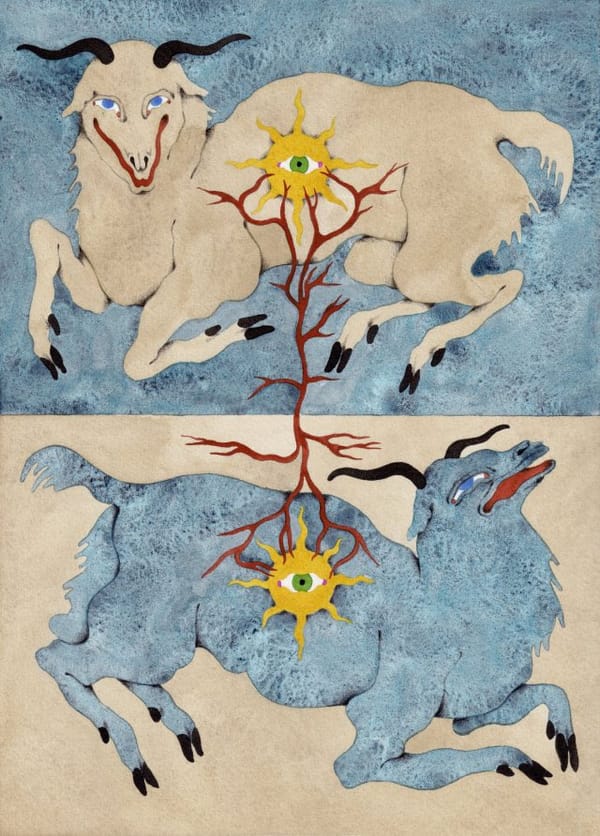When breaks make breakthroughs
The neuroscience of incubation

This post mentions the executive network, salience network, default mode network, and rumination. Sections 3 through 5 of this post introduce them.
I.
In the show Mad Men, it’s why Don Draper says to Peggy Olson: “Just think about it deeply, then forget it, and an idea will jump up in your face.” It’s why the philosopher Archimedes, stepping into a bathtub and seeing water splash over the edge, (allegedly) had an insight about the physics of buoyancy. It’s why r/ShowerThoughts exists.
The English term for this is “incubation.” The Mandarin term, translated into English, is “the brewing effect.” Under the hood, deep in the engine, some natural process like this is happening.
Even though the steps before and after this are crucial — first you need to think about the thing you’re trying to have an insight about, and afterward you need to implement it — the middle step is mysterious and interesting in a way those two aren’t.
Why do breaks make breakthroughs?
II.
Real convenient that Don gives Peggy this advice on incubation as she’s leaving work for the day; the scene might have unfolded very differently if he’d told her this while she was in the throes of writer’s block, knee-deep in a problem, straining her mind, spinning her wheels.
Stubbornness and pride can make us press on. Madison here knows it, I know it, and you know it. Our brain can get into a feverish, maniacal, “I’m going to finish this now if it kills me” state that hinders us. Our brains get foggy, clingy, tunnel-vision-y. The idea of leaving the problem alone for even 10 minutes can feel like utter defeat.
A break may sound easy in the abstract, but in that moment, taking a break, pulling yourself away from the problem, isn’t. The good “executive” decision seems to be “continuing to bang our heads against the problem.” The bad “default” decision seems to be “taking a break.” The opposite of true; a dead end.
What’s really happened is that your default mode network has grabbed your executive network by the collar, blocking it from “resetting” your attention in a more productive way, dragging it along for a ride. Your salience network could be jumping up and down, already alerting you to some clue or missing piece you need, but you’re unlikely to hear it over the screeching wheels of your default mode network. The key, and half the battle, is exercising your executive network to break this fixation, to disrupt your hyperactive-yet-fatigued default mode network.
This breaks your fixation not just on the problem itself, but on certain aspects of the problem you might be paying too much attention to. It gets you “unstuck,” not just from staring at the problem, but staring at it from the wrong angle.
III.
An interesting scientific finding, coming partly from putting jazz pianists in MRI machines and having them improvise, is that after you do this fixation-breaking, it’s once again your default mode network that wanders around, churning under the surface, causing incubation to work its magic.
When your executive network makes you take a break, your DMN doesn’t start “doing nothing.” As was the case with meditation, that isn’t the goal, and is like telling yourself “don’t think about penguins.” Your conscious brain would just gravitate back to the problem. That’s what we don’t want here, at least for 10-15 minutes.
The DMN becomes your friend again if your executive network acts on it the right way. You grab your attention like a construction crane, lift it out of the mud it’s spinning its wheels in, and put it down on something else where it can spin its wheels in a more relaxed way. You have to switch to something with lower, but not zero, mental effort: showering, boxing, gardening, chopping vegetables, playing an instrument, walking around outside.
It’s no coincidence that interventions like this on many different time scales serve as “hacks” in parallel ways. “Taking 10 seconds to breathe” for getting out of an angry state where you might do something rash. The spacing effect and sleep for learning. Meditation and psychedelics for mental illness. Even just looking away from whatever you’re looking at, like by looking at a white wall or closing your eyes, can help with triggering insight. This “loosening of fixation” pattern, in many cases, allows you to think better, more clearly. In fact, one direct way to take better advantage of incubation is to get better at switching your attention onto different things.
With your conscious mind out of the way, your executive network and default mode network not clashing, your DMN can really hum. Your conscious mind just has to let it cook. So what, exactly, does “cook” mean here?
IV.
In one experiment, peppering certain words into a problem statement, words that hint at the solution, made subjects more likely to reach the insight they needed. This, in other words, is how things go into the oven.
The pre-incubation stage, where you’re thinking about the problem, is where your brain first “understands the assignment.” It transforms and reformulates the problem or subject matter you’re dealing with. It builds bridges between your knowledge and what you’re trying to have an insight about.
Then our minds grab, or even cling to, certain “cues” about the problem. It’s here that our conscious brains have the unfortunate habit of getting fixated in certain ways, on certain cues, as we mull them over. We hold on to false assumptions; we consider too few angles on the problem; we scour too narrow of a solution space; we trap our thinking in boxes too small.
The change in the DMN’s processing that happens under incubation is a lot like making a whole camping group spread out and sweep the area to find trash, rather than making one person hunt. It makes your brain more likely to stumble on the “right” idea, or combination of ideas, for your purposes. And a quieter DMN gives your salience network an easier time bringing those “right” things to your attention. “Hey! Look at this! Eureka!”
In the West this sort of thing is counterintuitive. We’re an additive culture, a “more is more” culture. We don’t like solving problems by doing less. But that’s what we’re looking at here. Incubation is about getting out of certain assumptions about a problem, not piling them on. It’s about escaping a narrowness of vision and scope with which we’ve been thinking about something. Things must be broken, disrupted, undone, so new ideas and neural patterns can take their place.
V.
Why is it, then, that a mildly-focused DMN, rather than a totally unhinged one, is best? Contrary to what the tweet at the beginning suggests, certain waking activities actually do help much more than sleep.
When awake, your wandering mind will snake around in more targeted, beneficial directions. It’s not a random number generator. In incubation, your brain is neither idling nor freely dreaming. It’s really brewing something up.
Your DMN, in waking incubation, spreads its tendrils around these cues, sending them ever so loosely in the direction of goals we’ve been trying to achieve. It snakes around for relevant connections, in many directions at once, shuffling cues in various combinations, hopefully bumping into and turning up worthwhile connections and insights. The subconscious brain does this especially well when we’re in a good mood; this makes it feel “safer” surfacing strange new ideas.
How does it do this? How does it do the job so much better than our conscious brain, when it comes to letting all these cues seep in and interact?
Even though sleep is less effective, dreams remain relevant. Some of the papers I read explicitly said that if we knew more about the chaotic, free-associating, memory-replaying processes going on in REM sleep, we’d probably know a lot more about incubation and vice versa.
To better see how a subconscious mind can cook so effectively — chew on patterns and memory representations, develop them, combine them in helpful ways — it helps to review how well it picks them up in the first place. The brain is powerful and parallel. It literally can’t afford to be running just one thread at a time. It needs to be able to process and filter many things at once, many patterns, often below your conscious awareness, to help you survive.
VI.
Anyone who’s done at least a few jigsaw puzzles finds that gradually, without extra effort, they get better at knowing, feeling, that the piece they’ve spotted is the one they want. Likewise, people with dogs learn to detect the “poop walk” that signals your dog is seconds away from getting down to business: intensifying sniffs, more frequent direction changes, something about the gait you can’t describe. We habitually pick up on patterns; we reproduce them in art; we even see ones that aren’t there.
The weird thing to wrap your head around isn’t that our subconscious brains handle patterns differently than our conscious brains (and they do), but that it handles them, and handles them well. It does so in ways much more “outside the box” — free-wheeling, far-flung, ignorant of (potentially false) assumptions, conducive to attacking the problem from new angles — than our conscious mind.
In creativity and problem-solving, the missing puzzle pieces can come at you from any direction. A new cue or clue, maybe the one that produces a breakthrough, can come from your environment or unrelated memories or really anywhere. There’s Archimedes’s fabled bathtub; there’s Isaac Newton’s fabled apple. The insight you need may come from some faraway, unexpected connection that your frazzled, tunnel-visioned, conscious self is not likely to make.
When the moment of insight finally does occur, we see neural activity in parts of the right hemisphere where the default mode network and salience network interact, which brings us to an often-misinterpreted but based-on-a-grain-of-truth idea: the specialization of the “right brain” and “left brain.”
VII.
Both “problem-solving” insight and “creative” insight benefit from incubation. The creative kinds, e.g. “divergent thinking” or coming up with 100 different ways to use a hammer, benefit more. (The opposite, for clarity, is “convergent” thinking, the deductive, single-correct-answer kind that Sherlock Holmes might do.) The left brain is more logic- and language-focused. The right brain is more shapes-, colors-, and vibes-focused, more intuitive.
It makes sense that sudden insights — connecting concepts in a way that makes people say “whoa” — would be more of a “right-brained” enterprise. In scientific problems, like what Einstein would work on, it may be crucial, but it’s often a much smaller part of solving the problem, compared to the preparation and implementation.
At the end of the day, though, the brain is an entire organ; our corpus callosum connects the hemispheres. Both sides of the default mode network chew on things — patterns, memories, cues — in ways that produce insight.
I’ll restate the challenge of incubation in a way that makes it independent of this left-right issue: incubation is where you make just the right far-off connection, stumble upon just the right clump of mental representations, to solve a problem or generate an idea expressible through art.
Whatever the brain’s doing under the hood, it’s about a lot more than just the “aha!” moments of abstract tasks like discovering a new physical formula or finding brilliant moves in chess. It’s impoverished and limiting to only ever focus on types of insight that revolve around a “right answer.” Human flourishing relies on more creative and generative types of insight, in art and engineering and design, that benefit even more from incubation. These produce new, interesting juxtapositions, bringing us original, innovative ideas. It’s tough to measure and reproduce good brainstorming of this kind. Many insights are not things with a deterministic “best” outcome; they’re things no one has thought of before, connections that the thinker knows are good but may not be able to explain why until they implement them.
VIII.
Obviously we want to ignore this and keep digging. We want to know: what’s the secret sauce? What’s the precise brain magic that causes the right connection to form, and make it bubble up? Can we do this predictably, reproducing it every time?
I’m not going to go further in that direction for two reasons. One is that it would get boring; I would be out of my depth. Things beyond my pay grade about “gamma band oscillations” and “cross-frequency coupling” start to apply. Neural assemblies, the things that cause EEG patterns, couple up their frequencies in certain ways; faraway neural representations, the “right” ones for whatever we’re doing, get bound up together and produce an “aha.” I can’t effectively communicate how. Not yet.
The other reason, which actually represents a hard limit, is that this is a “cultivate the conditions that make it happen” thing, not a “find a way to reproduce it every time” thing. Incubation is mysterious for reasons beyond the fact that we haven’t studied it enough. There’s something fundamentally chaotic about this process, something inherently akin to “letting go” involved here. There’s a deliberate relinquishing of attention on specifics that’s required. Even though we can put people in MRIs and hope they have insights, there’s something about measuring this that disturbs the conditions under which the best insights come about.
This lack of perfect reproducibility, a chaotic “snow globe” nature to the problem, is something I don’t think we can get around. Not yet.
The question it actually pays to learn more about: when is it more likely that insight will happen? How do we maximize the chance that our top-down models of the problem will link up with the right bottom-up resources, dredged up from our memory and experience by subconscious machinery?
It’s like creating a garden for things to grow. It’s like hatching eggs or brewing beer. The goal is to optimize conditions like a master brewer, not attempt the (prohibitively and fundamentally hard) task of isolating the “correct signals” and ensuring that the brain finds them every time.
IX.
The brain wants an open field. Green space. It wants certain conditions cultivated; it wants surroundings that maximize the frequency of productive insight occurring. It wants a wider set of potential “cues” to focus on, to bounce around between, including chaotic ones from the environment. The more an artist or scientist can be engaged with the present moment, and with their own daydreams and fever dreams and actual dreams, the more fertile their imagination; the better their insights.
Until we know much more about how it works, it’ll work the way Paul Rudd describes a cologne his character wears in Anchorman: 60% of the time, it works every time.
It’s also apparent that many things about our lives, institutions, and systems don’t work well with these facts; they don’t listen to this data. We have a Protestant capitalist work ethic that says taking your attention off the problem is lazy; we have many prevailing models of the mind that say your subconscious is a big dumb brute that doesn’t do anything useful.
I write posts like this largely out of personal curiosity and largely out of spite. I can’t stand by and watch these antiscientific idiots — the ones who proposed this bill, and DeSantis, and Greene — succeed. May we learn enough to leave them behind; may their destructive ignorance become irrelevant.
Like the DMN post, this one relies on a bunch of different resources. Most are in my browser bookmarks. Here were the most informative ones.
Papers:
- The cognitive neuroscience of insight
- Large-scale brain network associated with creative insight
- The incubation/“brewing” effect of creative thinking
- Creativity — the unconscious foundations of the incubation period
- Chain free association, creativity, and the default mode network
- Neural activity when people solve verbal problems with insight
- Mechanisms underlying incubation in problem-solving: Evidence for unconscious cue assimilation
- EEG signals respond differently to idea generation, idea evolution and evaluation in a loosely controlled creativity experiment
- Altered brain connectivity patterns of individual differences in insightful problem solving
- Neural oscillation mechanism of creativity
Psychology StackExchange:
- How is it that taking a break from a problem sometimes allows you to figure out the answer?
- Can incubation be facilitated while being focused on a different problem?
A great interview:




